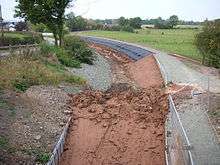Puddling (engineering)

Puddling is both the material and the process of lining a water body such as a channel or pond with puddle clay (puddle, puddling) - a watertight (low hydraulic conductivity) material based on clay and water mixed to be workable,[1]
Puddle clay as a lining
Puddling is used in maintaining canals or reservoirs on permeable ground. The technique of puddling and its use was developed by early canal engineer James Brindley; it is considered his greatest contribution to engineering.[2] This processed material was used extensively in UK canal construction in the period starting circa 1780. Starting about 1840 puddle clay was used more widely as the water-retaining element (or core) within earthfill dams, particularly in the Pennines. Its usage in UK dams was superseded about 1960 by the use of rolled clay in the core, and better control of moisture content.
A considerable number of early notable dams were built in that era and they are now sometimes referred to as the 'Pennines embankment' type. These dams are characterized by a slender vertical puddle clay core supported on both sides by earthfill shoulders of more heterogeneous material. To control under-seepage through the natural foundation below the dam, the Pennines embankments generally constructed a puddle clay-filled cutoff trench in rock directly below the central core. Later construction often used concrete to fill the cutoff trench.[3]
To make puddle, clay or heavy loam is chopped with a spade and mixed into a plastic state with water and sometimes coarse sand or grit to discourage excavation by moles or water voles. The puddle is laid about 10 inches (25 cm) thick at the sides and nearly 3 ft (0.91 m) thick at the bottom of a canal, built up in layers. Puddle has to be kept wet in order to remain waterproof so it is important for canals to be kept filled with water.
The clay is laid down with a tool called a 'punner', or 'pun', a large rectangular block on a handle about 5 feet (1.5 m) long, or trodden down, or compacted by some other means (e.g. by an excavator using the convex outside of its scoop, or, historically, by driving cattle across the area).
Puddle as a building material
Puddle clay or puddle adobe is often called cob. Cob has added ingredients of a fibrous material to act as a mechanical binder.
See also
Notes
- ↑ "puddle, n. 4" also called puddling. Oxford English Dictionary. 2nd. ed. 2009.
- ↑ Rolt, L.T.C. (1969). Navigable Waterways. W & J Mackay.
- ↑ George M. Reeves, Ian Sims, J. C. Cripps Eds., Clay Materials Used in Construction, p.377. Geological Society, 2006. ISBN 978-1-86239-184-0
External links
References
- Waterways in the Making, Edward Paget-Tomlinson, The Landscape Press, 1996, ISBN 978-0-947849-03-0
- The Illustrated History of Canal and River Navigations, Edward Paget-Tomlinson, Landmark Publishing Ltd., 2006, ISBN 1-84306-207-0
